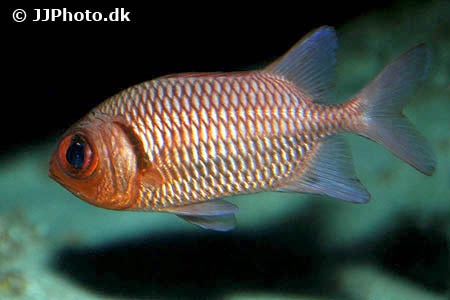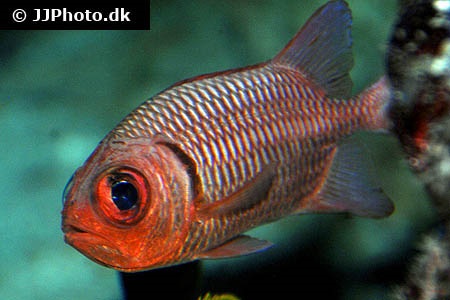Myripristis hexagona


| Latin name | Myripristis hexagona - (Lacepède, 1802) |
|---|---|
| Local name | Doubletooth soldierfish |
| Family | Holocentridae - Myripristis |
| Origin | East Indian Ocean, West Indian Ocean, Australia, The Red Sea, Indonesia, East Pacific, Central/West Pacific |
| Max length | 30 cm (11.8") |
| Minimum volume |
600 l (158 gal) |
|---|---|
| Hardiness |
Hardy |
| Suitable for aquarium |
Suitable with care |
| Reef safe |
Reef safe with caution |
| Aggressiveness | Mostly peaceful but might be aggressive towards similar species |
| Recommended |
Fish Larger crustaceans (Shrimp, crabs...) Other invertebrates Small crustaceans (Krill, mysis, artemia...) Zooplankton (Cyclops, pods...) |
|---|
This spicies might be a threat to smaller fishes.
This species can be a threat towards small crustaceans, e.g. small shrimp.
These fish should not be caught with a net, as it is all too easy to damage their large eyes.
Out in wild this species is used to faint light, so to acclimitize it, it is advantageous to dim the light at first and gradually increase it to normal.
A very secretive species which hides between the rocks.
When it feels at home in the aquarium it will appear more, but is still not as active in the water column as most of the other fish.
This species thrives best in an aquarium with overhangs and caves.
This species can be aggressive if they are not provided with adequate space.
This species is nocturnal and therefore the most active when the light is dimmed or turned off.
Several specimen of this species can coexist in the same aquarium, provided they are introduced simultaneously.
Squirrel-/Soldierfish (Holocentrinae and Myripristinae) are normally a red/grey colour and very secretive.
As to how much they hide, varies from fish to fish, what they do have in common however, is that they are most active when the lights are off, but will, with time, come out more while the lights are on.
Squirrel-/Soldierfish are not generally a threat to other aquarium animals, but will sometimes eat very small fish and invertebrates.
Neither Squirrelfish or Soldierfish are particularly aggressive, and whilst most species can be kept in a small group, they will sometimes fight amongst themselves. In this case, space must be taken into consideration as the Squirrelfish will sometimes chase the less aggressive Soldierfish, if space is lacking.
It is easy enough to get both fish types to eat, but if they do not come out during the day it is best to feed them when the lights are off. In the beginning it might be necessary to lure them out with live food.
Squirrelfish have spikes on their head and gills which easily get caught in fishnets, so avoid those.
Being scratched by some species of Squirrelfish can result in an ugly wound and be painful, as some are actually poisonous.
If one is not careful when capturing and transporting these fish, their eyes can be damaged.
| Aquarium trade | No |
|---|---|
| Distribution | Indo-Pacific: East Africa to Samoa, north to the Ryukyu Islands, south to the Great Barrier Reef and New Caledonia. Palau in Micronesia (Ref. 1602). It has not been found on low islands or atolls of the Indo-Pacific. |
| English common names |
Doubletooth soldierfish |
| Danish common names |
Dobbelttandet soldaterfisk |
Scott W. Michael. 2001. Reef Fishes volume 1 - TFH Publications / Microcosm Ltd. - (English)
Henry C. Schultz. 2003. But They Don't Look Like a Rat with a Fuzzy Tail: The Family Holocentridae - Reefkeeping Magazine - (English)
Bob Fenner. Squirrel- & Soldierfishes, Family Holocentridae - Wet Web Media - (English)

